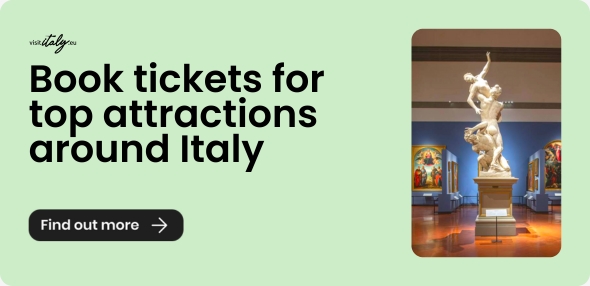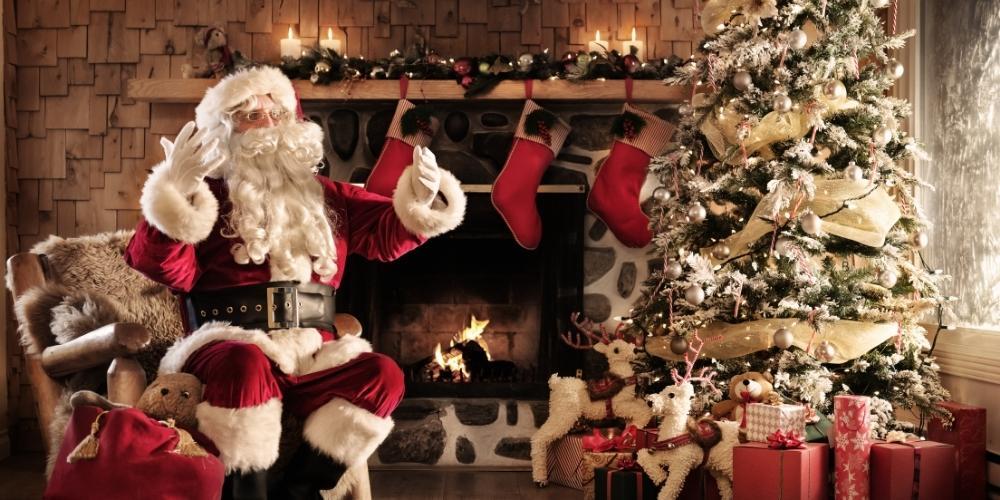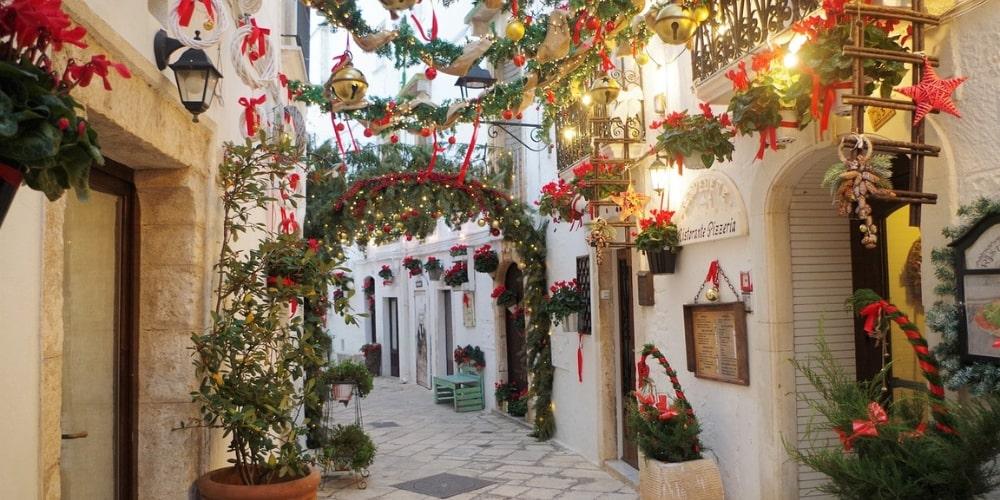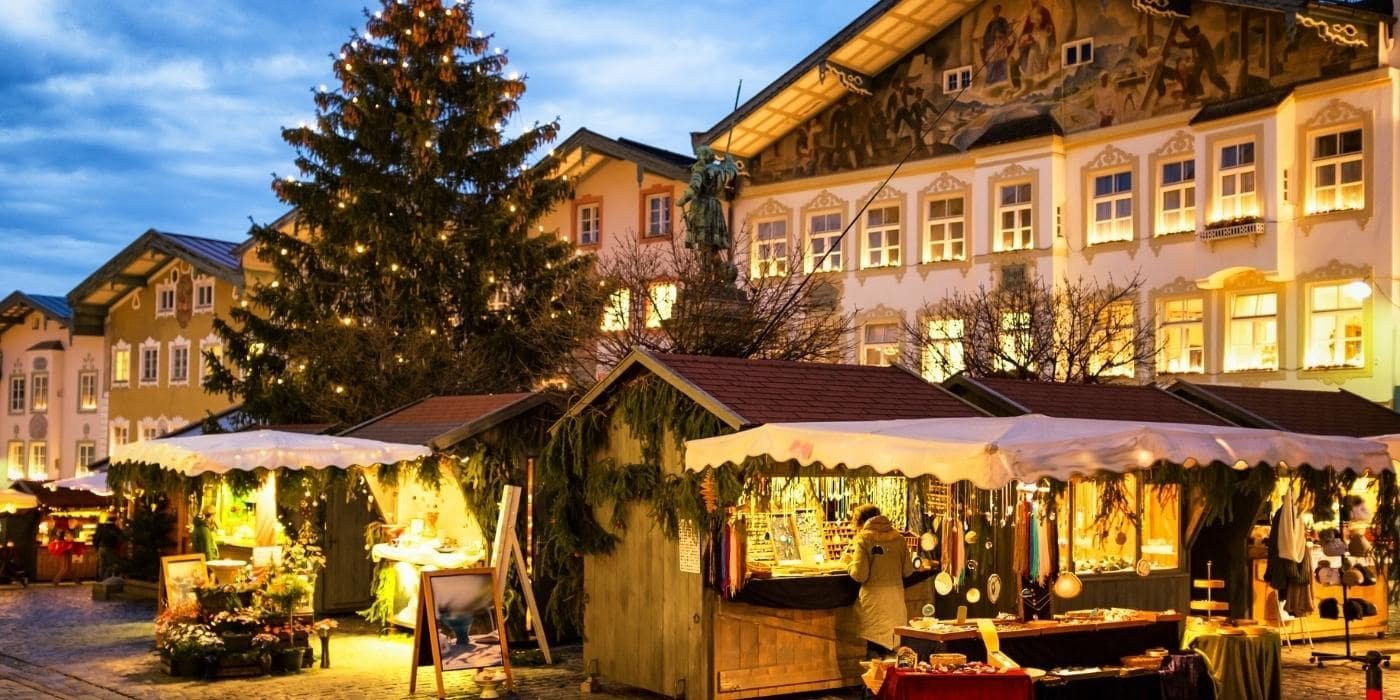Are you looking for some original ideas to plan exciting Christmas trips to Italy and to enjoy a pleasant stay admiring historical nativity scenes and enchanting markets? During the whole year, The Christmas holidays represent one of the most favourable and desired occasions to relax and enjoy a fantastic holiday in the company of relatives, friends, and loved ones.
The magical time of Christmas in Italy is made even more charming and evocative by the decorations and illuminations, which brighten up the atmosphere, tinging it with the spectacular colours of the feast. Here you will find a valuable guide to the rites, symbolism, itineraries, fascinating traditions and gastronomic specialities of the feast days.

Christmas trips in Italy: discover the origins of this festivity
Are you curious about the origins of Christmas before undertaking your beautiful Christmas trips in Italy? Its celebration in Italy is rich in cultural and religious stratifications, overlapping ancestral ceremonies, and pagan cults. The origins of Christmas in fact date back to the Roman religious cult. On the occasion of the winter solstice, the Saturnalia feasts were celebrated. They were an archaic cycle of festivities, the duration of which had been established by the emperor Diocletian: this feast glorified Saturn, the deity of sowing, farming, the countryside, and the harvest to propitiate the prosperity and splendour of the Golden Age, characterised by abundance and wealth.
During this time, the Ancient Romans interrupted agricultural practices, and opulent banquets were set up; the origins of Christmas can be traced back to the custom of the ancient Romans of visiting relatives, and close friends and exchanging gifts. In this circumstance, the festivities allowed greater freedom for all social classes, including slaves, who enjoyed temporary civil rights they couldn't usually take advantage of.
They designated a so-called princeps to represent the deity of the underworld and the protector of harvests and a parody of the aristocratic class. Due to the reform of the Roman calendar, carried out by Julius Caesar in the 1st century B.C., the date of the Solstice was postponed to December 25th, beginning to outline the origins of Christmas.
This change was enabled thanks to the valuable partnership of the Egyptian astronomer Sosigene of Alexandria, who was in charge of reformulating the pre-existing calendar.
History of Christmas
Would you like to know the evocative and thousand-year-old history of Christmas before arranging your charming Christmas trips in Italy? In this excursus it is possible to discern phases, stratifications, and elements derived from other cultural traditions, among which the cult of Mithras, such as the very own date of December 25th. Following the expansion of the empire and the cultural contributions of eastern peoples, religious syncretism intensified. Between the 1st and 3rd century A.D., the influences of this religion of Persian origin, linked to light, reached Rome. Mithraism is an ancient form of religiosity, dating back to 1300 B.C., which has some parallels with Christianity. We can find some similarities between pagan rites and baptism or regarding the miracles performed by Mithras and St. Peter.
The history of Christmas has undergone the influence of the contaminations of the feast of Natalis Solis Invicti, instituted by the emperor Aurelian in 274 A.D. This festivity commemorated the pagan cult of Mithras and Apollo and the rising of the Sun after the darkness of the winter season. During the same period, Ancient Romans celebrated the Divalia, the ancient ceremonies in honor of the mysterious Angerona, the deity of compassion, silence, and secret love as well.
In the long history of Christmas, during the episcopate of Julius I, they chose the date of 25th December to glorify the birth of Jesus Christ. In 529, Justinian set it forth as an official calendar holiday.
The history of Christmas overlaps other peculiar millennial traditions, concerning the celebration of the theme of light and of rebirth. In combination with Christian Christmas, Hanukkah or Chanukkah, the festival of lights, is also celebrated, commemorating the consecration of the altar of the ancient temple of Jerusalem, dated 161 BC, and its reconquest. This feast honours the liberation from Seleucid tyranny and oppression by the Syrian ruler Antiochus IV, whose vast kingdom formerly included the Israeli territories.
Christmas in Italy and Saint Nicholas Feast day
One of the most eagerly awaited celebrations of Advent and of Christmas in Italy is the feast of St. Nicholas, whose widespread cult is celebrated on December 6th in Italy. It is a heartfelt festivity in the magnificent city of Bari, which feels strong affection and worship for the patron saint, in Lecco, Val Gardena, Trieste, Molfetta, Bolzano, in the province of Belluno, in South Tyrol, and Friuli. According to tradition, he gave necessities and money to the needy.
The Saint was born in Patara of Lycia, in current Turkey, between 260 and 280 A.D. He belonged to a wealthy family and he grew up in a monastery. After moving to Myra, he has been ordained its bishop and he was a victim of persecutions carried out by the Roman emperor Diocletian against Christians. Over time, his figure, characterised by a charitable spirit and linked to numerous legends of prodigious events, has been associated with the role of a bearer of gifts. According to a folk tale, he fed three children by giving them three apples, which the day after took on the appearance of precious golden fruits. In Middle Ages, it became customary to hand out presents to children to pay homage to the Saint.
Santa Claus

Following the crossings made by Dutch and British sailors to reach the American continent between the 17th and 18th centuries, the legendary and influential figure of St. Nicholas, before the bishop of Myra and later patron saint of Bari, landed on the American continent, where he took on the name Sankt Nikolaus. According to Dutch tradition, he wears a red outfit, white gloves, and a miter, and he is depicted with a thick white beard. To make it more easily pronounceable by the people of New England and to adapt it to American phonetics, his name underwent further changes to become St. Claus.
In 1809, the American writer Washington Irving, in his famous folk tales, talks about the first Dutch settlers in the New World, mentioning that they invoked the protection of Saint Nicholas during their journey. Furthermore, the poem A visit from Saint Nicholas, composed in 1822 by Clement Clark Moore, refers to an elf who leads a sleigh pulled by his eight reindeer and who donates toys and gifts for children passing through chimney pots. Moreover, it portrays some aspects and features of this mythical character.
His traits, which entered the collective imagination of entire generations, emerged further from his description in the poem The Night Before Christmas, published in the local newspaper The Sentinel in 1823, which references eight reindeer. The well-known works of illustrator Thomas Nast, published in Harper's Weekly magazine, have influenced his current depiction.
Christmas trips in Italy: the rites of Christmas festivities

The Christmas season is rich in customs, and beguiling rituals, handed down over the centuries, which you can discover during your Christmas trips to Italy. Evocative traditions create a peculiar fairy-tale atmosphere that shrouds everything, depicting an enchanted landscape. During the trips you will undertake in the holiday season, you will be mesmerised by the magic of several symbols and colours of Christmas. The custom of decorating Christmas trees derives from the ceremonies of the ancestral Germanic peoples, who adorned the fir trees with multicoloured ribbons, harmonious bells, and typical torches. The Vikings were used to practice similar rituals by decorating spruce trees to celebrate the festival of light and rebirth and to propitiate fertility on the occasion of the winter solstice.
The Celtic druids gave great importance to the fir tree as a symbol of longevity; so they began decorating it to exorcise the darkness of the cold season. In the Middle Ages, the legacies of ancient cults, customs, and traditions began to be assimilated into Christian traditions, making a few changes to adapt them to the canons of the new religion. You can note the gradual replacement of the characteristic pines and fir trees, the quintessential symbols of the Christmas festivities, with holly, whose morphology figuratively recalls the image of Christ, encircled by the crown of thorns. In the 19th century, Queen Margherita, wife of the monarch Umberto I of Savoia, spread a tradition in vogue at European courts to Italy. They started setting up a wonderful Christmas tree embellished with glass balls in the halls of the Quirinale.
Among the typical and traditional rituals of the rural world, it is worth mentioning the peculiar Christmas log, whose history dates back to ancient times, even as far back as the 12th century. On Christmas Eve, the head of the family had to light a log of oak or other types of wood in the hearth, to which straw and other twigs were added. The family took special care to ensure that combustion came along gradually. The flame had to be stoked without interruption between Christmas Eve and Epiphany. Each day of this time represented a month of the year. Moreover, according to tradition, they could gather predictions about the harvest by observing the flames. The log thus acquired a symbolic value and what remained from the combustion took on a thaumaturgical power. It brought about an abundance of crops, and health in the house.
Fascinating destinations to spend Christmas in Italy
We advise you to visit some beautiful destinations for your next Christmas travels in Italy, such as charming Bolzano, Merano, Courmayeur, Selva Val Gardena, Cortina d’Ampezzo, Madonna di Campiglio, Villalago, Asiago, Sant’Agata Feltria, Candelara, Civita di Bagnoregio, Orvieto, Longiano, and Poffabro.
When the tradition of the nativity scene is born
Another fundamental symbol of the varied heritage of Christmas traditions is the fascinating nativity scene, the preparation of which dates back to the religious practices of the Etruscan and Latin worlds. A curiosity: it was customary for children to take care of the small statues of the Lari, the family ancestors, and arrange them in a picturesque and colourful rustic landscape, which would be a precursor to the traditional nativity scene.
The habit of re-enacting the Nativity scene dates back to St. Francis of Assisi, who depicted the evangelical scene in a cave in Greccio in 1223 after traveling to Palestine. In Italy, the art of the representation of the nativity scene is widespread and it is one of the essential cornerstones of Christmas traditions. Strolling through the ancient historical centres or magnificent churches and cathedrals embellished with polychrome marble, along the cobbled streets, and in the iconic squares of delightful villages, you can admire authentic artistic masterpieces, which are a boast of our cultural heritage and craftsmanship.
Among the copious holy representations you can contemplate in December, in the enchanting setting of the elegant Piazza Vittorio Emanuele II, you will admire an impressive and marvelous manger scene. Indeed, the size of this work of art is its peculiarity: visitors can walk inside to catch sight of evocative views. The marvellous historic nativity scene of Cavallermaggiore, in the province of Cuneo, is a masterpiece, created in 1976, that covers an area of more than 300 square metres. It is embellished by enchanting water games and hypnotic lighting effects which mark the passage from day to night. You will be mesmerized by the charm of its precious statues, some of which date back to the 18th century. This alluring scenography, enriched with refined fabrics and terracotta statues, allows you to rediscover picturesque glimpses of daily life and typical trades of the Piedmont region in the early 1900s.
Christmas trips and Feast day of Saint Lucy
Among the many festivities and legends of Christmas in Italy and of the winter season, December 13th is the feast day of Saint Lucy. Its origins are related to ancient rural civilization and the transition from the darkness of the cold season to the prevailing hours of light, anticipating the arrival of Spring. In ancient times, it was customary in rural areas for those who had obtained more luxuriant crops to donate a portion to the needy.
Firstly, there are also folk tales and legends that talk about the famine, that took place in the Brescian area in the 16th century. Because of this event, inhabitants of the province of Cremona planned a solidarity intervention by distributing cereals to people who were in a hard place. Over time, the custom of celebrating Saint Lucy and giving gifts and sweets to children was born and consolidated. On the evening of December 12th, they prepared biscuits and dessert wine for Saint Lucia and carrots and straw for the donkey on whose back she arrived.
Historically, Saint Lucy was a Christian martyr born in Syracuse in 283 A.D. and a victim of the Roman Emperor Diocletian's persecution of the followers of Christianity. After benefiting from her mother's miraculous healing at the shrine of Saint Agatha in Catania, she dedicated her life to supporting the needy. According to tradition, the Roman emperor Constantine chose the date of her martyrdom to celebrate her cult.
Do you want to know where Saint Lucy is celebrated? The devotion to the patron saint of sight in Italy is heartfelt in Lombardy, particularly in Bergamo, Brescia, Mantua, Lodi, Cremona, Veneto, Verona, Emilia, Apulia, and Sicily. The magnificent city of Syracuse dedicates a whole week to this festivity with religious celebrations, during which the participants wear traditional clothes. They also prepare uggioli, votive rolls with a characteristic eye shape and an apotropaic and sight-protective value to distribute to fellow diners. Furthermore, cuccia is another delicious speciality made with sheep ricotta cheese, wheat, and honey.
What to see during the Advent period: Christmas markets
The magical Christmas markets, which brighten up the squares of the cities and ancient villages during feast days, create a fairytale atmosphere. During your Christmas holiday trips in Italy, you will find fine works of local craftsmanship, such as statues depicting traditional nativity scene characters. Moreover, you can taste delicious gastronomic specialities, exquisite mulled wine, and great ideas for original gifts for family and friends, nearby the holidays.
Their ancient history dates back to the Late Middle Ages when these markets were organized in some territories of the previous Holy Roman Empire. They took place at the start of the winter season. Probably the forerunner was the Dezembermarkt in Vienna, which occurred initially in 1298 when Emperor Albrecht I reigned. Later, during the 15th century, the first Advent markets took place in Dresden, Salzburg, and Nuremberg. Artisans set up an exhibition of works inspired by the iconography of Advent, Nativity scenes, and the Holy Family.
In the beginning, people knew them as St. Nicholas' markets, but they took on the name of Baby Jesus' markets in the 16th century. This tradition has spread throughout the Alps throughout the centuries from Germany to France and Austria, and it arrived in Italy only in Bolzano in 1990. Over time, this custom reached the surrounding towns and regions: the enchanting markets of Bressanone, Brunico, Merano, Vipiteno, Belluno, Andalo, and Levico, nestled among the beautiful landscapes of Sugana valley, were born. They were also arranged to Piedmont, in places like Govone and Turin, and they were assimilated within the varied panorama of local traditions. If you want to savour the spirit of the Christmas festivities in a charming and picturesque location, we suggest you visit the traditional Christmas market of Levico Terme to admire the spectacular landscapes of Sugana Valley in Trentino Alto Adige.
Let yourself be allured by the festive atmosphere of this enchanted place, exploring which it will seem to you to take a journey back in time, to rediscover the elegance of the era of the Imperial Court. Within the oasis of the luxuriant Hapsburg Park, a marvellous historical garden that has entered the elite of the Great Italian Gardens, you will relive the splendour of the Belle Epoque by taking part in evocative historical re-enactments. Strolling along beautiful tree-lined avenues, you can contemplate characteristic wooden houses with sloping roofs. They are embellished by typical holly and enchanting illuminations where exhibitors offer the best handicrafts and the traditional flavours of local gastronomic specialities, such as the delicious local boar ham and the delicious mountain honey. You can also taste aromatic mulled wine or parampampoli, a typical Trentino product with high alcoholic strength, made from wine, grappa, tasty honey, and sugar.
Italian Christmas desserts
Within the multifaceted panorama of Christmas traditions, regional gastronomy offers people who wish to embark on enchanting Christmas journeys to Italy opulent tables laden with many delicious regional specialties and desserts to taste.
In Bologna, people celebrate Christmas feast days by preparing Certosino or Spiced Bread, whose recipe dates back to the Middle Ages. Later, production passed to the Carthusian monks of the Certosa di Bologna. Its pastry consists of flour, pine nuts, almonds, honey, cocoa, chocolate, mostarda, and quince jam. The garnish includes the addition of candied fruits, honey, walnuts, and a honey glaze.
Other Italian regional specialities you can taste during the Christmas season are gubana, well-known ricciarelli, mustaccioli, bisciola, Sicilian buccellato, typical roccocò, and savoury strauben.
Christmas holiday trips in Italy: symbols, destinations and culinary specialities of the feast days

Photo from Pixabay - la valigia in viaggio
• Christmas trips in Italy: discover the origins of this festivity
• History of Christmas
• Christmas in Italy and Saint Nicholas Feast day
• Santa Claus
• Christmas trips in Italy: the rites of Christmas festivities
• Fascinating destinations to spend Christmas in Italy
• When the tradition of the nativity scene is born
• Christmas trips and Feast day of Saint Lucy
• What to see during the Advent period: Christmas markets
• Italian Christmas desserts
About the author
Written on 23/11/2022



Simone Pini
Are you dreaming of Christmas holiday trips to Italy? Discover symbols, rites, destinations, and delicious regional recipes of the feasts with us.